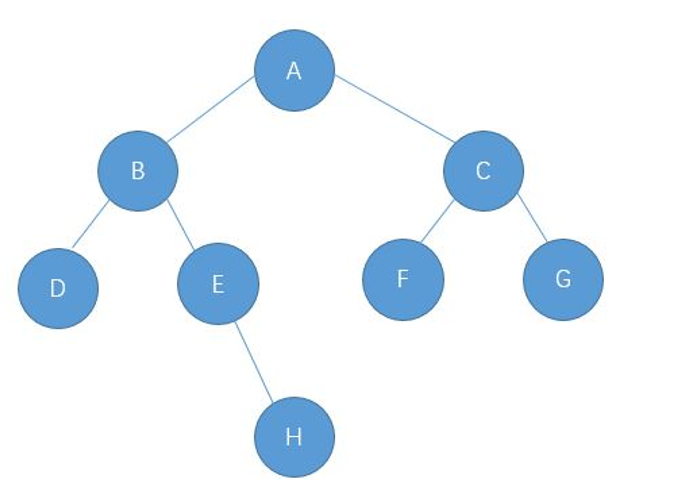已知二叉树的序列求它的形状:有三种方法:
- 1.根据前序+中序可以求出
- 2.根据中序+后序可以求出
- 3.只利用“前序”构建二叉树
方法一:根据前序+中序可以求出
思想:0)一定要先判断长度是否为0
1)前序遍历的第一个元素为二叉树的根结点,再在中序遍历中找根节点的位置leftCount
2)在前序遍历中根节点左边的的数组范围为:[1,leftCount+1);
在中序遍历中根节点左边的的数组范围为:[0,leftCount);
在前序遍历中根节点右边的的数组范围为:[leftCount+1,preorder.length);
在中序遍历中根节点右边的的数组范围为:[leftCount+1,inorder.lenght);
3)重新定义Node结点的头结点,left进行递归,preorder为前面数组中前序的左边,inorder为前面数组中中序的左边,进行 递归查找元素,right进行递归,preorder为前面数组中前序的右边,inorder为前面数组中中序的右边,进行递归;
4)返回
例子:

前序遍历为:ABDEHCFG 中序遍历为:DBEHAFCG
代码如下:
1
2
3
4
5
6
7
8
9
10
11
12
13
14
15
16
17
18
19
20
21
22
23//根据先序+中序数组确定二叉树(利用数组) public static Node buildTree1(char [] preorder,char [] inorder) { if(preorder.length==0){ return null; } char rootValue=preorder[0]; int leftCount=0; for(int i=0;i<inorder.length;i++){ if(inorder[i]==rootValue){ leftCount=i; } } char [] leftPreorder= Arrays.copyOfRange(preorder,1,leftCount+1); char [] leftInorder=Arrays.copyOfRange(inorder,0,leftCount); char [] rightPreorder=Arrays.copyOfRange(preorder,leftCount+1,preorder.length); char [] rightInorder=Arrays.copyOfRange(inorder,leftCount+1,inorder.length); Node root=new Node(rootValue); Node left=buildTree1(leftPreorder,leftInorder); Node right=buildTree1(rightPreorder,rightInorder); root.left=left; root.right=right; return root; }
方法二:根据中序+后序可以求出
思想:0)一定要先判断长度是否为0
1)后序遍历的最后一个元素为二叉树的根结点,再在中序遍历中找根节点的位置leftCount
2)在中序遍历中根节点左边的的数组范围为:[0,leftCount);
在后序遍历中根节点左边的的数组范围为:[0,leftCount);
在中序遍历中根节点右边的的数组范围为:[leftCount+1,inorder.lenght);
在后序遍历中根节点右边的的数组范围为:[leftCount,postorder.length-1);
3)重新定义Node结点的头结点,left进行递归,inorder为前面数组中中序的左边,postorder为前面数组中后序的左边,进 行递归查找元素,right进行递归,inorder为前面数组中中序的右边,postorder为前面数组中后 序的右边,进行递归;
4)返回
例子:

中序遍历:DBEHAFCG 后序遍历:DHEBFGCA
代码如下:
1
2
3
4
5
6
7
8
9
10
11
12
13
14
15
16
17
18
19
20
21
22
23//根据中序+后序确定二叉树(数组) public static Node buildTree2(char [] inorder,char [] postorder){ if(inorder.length==0){ return null; } char rootValue=postorder[postorder.length-1]; int leftCount=0; for(int i=0;i<inorder.length;i++){ if(inorder[i]==rootValue){ leftCount=i; } } char [] leftInorder=Arrays.copyOfRange(inorder,0,leftCount); char [] leftPostorder=Arrays.copyOfRange(postorder,0,leftCount); char [] rightInorder=Arrays.copyOfRange(inorder,leftCount+1,inorder.length); char [] rightPostorder=Arrays.copyOfRange(postorder,leftCount,postorder.length-1); Node root=new Node(rootValue); Node left=buildTree2(leftInorder,leftPostorder); Node right=buildTree2(rightInorder,rightPostorder); root.left=left; root.right=right; return root; }
方法三:只利用“前序”构建二叉树
思想:在前序遍历中,没有结点的位置要用'#'代替
1)ReturnValue职责:用root构造出一棵树,使用Node结点,用used确定使用过的值
2)先判断长度是否为空
3)先序的第一个结点为结点,rootValue
4)判断节点是否为'#',如果是的话,root为null,used加1;
5)利用找先序中的左边和右边
6)最后确定root结点的left、right
1
2
3
4
5
6
7
8
9
10
11
12
13
14
15
16
17
18
19
20
21
22
23
24
25
26
27
28
29//只利用“前序”构建二叉树 public static class ReturnValue{ Node root; int used; } public static ReturnValue buildTreePreorder(List<Character> preorder){ if(preorder.size()==0){ ReturnValue rv=new ReturnValue(); rv.root=null; rv.used=0; return rv; } char rootValue=preorder.get(0); if(rootValue=='#'){ ReturnValue rv=new ReturnValue(); rv.root=null; rv.used=1; return rv; } ReturnValue leftPreoder=buildTreePreorder(preorder.subList(1,preorder.size())); ReturnValue rightPreorder=buildTreePreorder(preorder.subList(1+leftPreoder.used,preorder.size())); Node root=new Node(rootValue); root.left=leftPreoder.root; root.right=rightPreorder.root; ReturnValue rv=new ReturnValue(); rv.root=root; rv.used=1+leftPreoder.used+rightPreorder.used; return rv; }
最后
以上就是缓慢超短裙最近收集整理的关于(数据结构)已知二叉树的序列求它的形状(用java实现)的全部内容,更多相关(数据结构)已知二叉树内容请搜索靠谱客的其他文章。








发表评论 取消回复